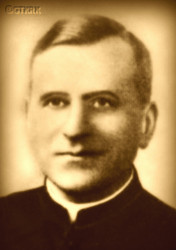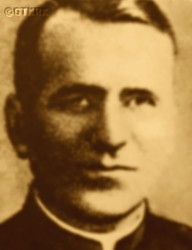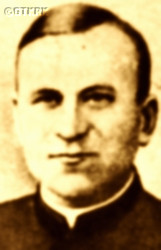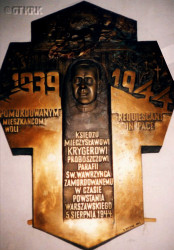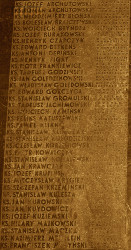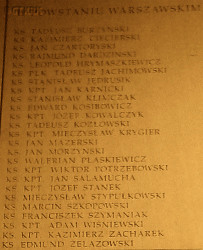Roman Catholic
St Sigismund parish
05-507 Słomczyn
85 Wiślana Str.
Konstancin deanery
Warsaw archdiocese, Poland
full list:
displayClick to display full list

searchClick to search full list by categories
wyświetlKliknij by wyświetlić pełną listę po polsku

szukajKliknij by przeszukać listę wg kategorii po polsku

Martyrology of the clergy — Poland
XX century (1914 – 1989)
personal data
surname
KRYGIER
surname
versions/aliases
KRYGER
forename(s)
Mieczyslav (pl. Mieczysław)
function
diocesan priest
creed
Latin (Roman Catholic) Church RCmore on
en.wikipedia.org
[access: 2014.09.21]
diocese / province
Warsaw archdiocesemore on
en.wikipedia.org
[access: 2013.05.19]
RC Military Ordinariate of Polandmore on
en.wikipedia.org
[access: 2014.12.20]
honorary titles
Rochettum et Mantolettum canonmore on
en.wikipedia.org
[access: 2014.11.14]
War Order of Virtuti Militari — Silver (5th Class)more on
en.wikipedia.org
[access: 2019.10.13]
date and place
of death
05.08.1944

Warsawtoday: Warsaw city pov., Masovia voiv., Poland
more on
en.wikipedia.org
[access: 2021.10.09]
alt. dates and places
of death
06.08.1944
details of death
In 01.1920, after the rebirth of the Polish state in 11.1918, voluntarily joined the Polish Army.
Took part — as a chaplain of the 13th Heavy Artillery Regiment — in the Polish–Russian war of 1919‐1921. The regiment took, among others, part in the Polish Army expedition to Kiev (in 04‐06.1920), securing crossings on the Dnieper river. Then, during the Russian counteroffensive, one of its units, the 1st Battery, participated in delaying the offensive of the Rus. Первая Конная армия (Eng. 1st Horse Army) under the command of Semyon Budyonny, taking part in the battles of Napadivka on 31.05.1920 and Zbarazh 20‐25.07.1920. Meanwhile, the 1st Division was transferred to the Northern Front, where it fought as part of the 1st Lithuanian–Belarusian Division, e.g. on the Neman River, delaying the actions of the Russian ros.
Западный фронт (Eng. Western Front), under the command of General Mikhail Tukhachevsky. Prior to the so‐called the Battle of Warsaw on c. 15.08.1920, known as the „Miracle on the Vistula”, participated in skirmishes on the outskirts of Warsaw. Finally, after Polish triumph in the aforementioned battle, transferred at the end of 08.1920 near Rivne and Dubno in Volyn and took part in pursuit of fleeing Russians.
In 1922 transferred to the reserves of the Polish Army. In 1923, 1924, 1925, 1927 and 1929 appointed reserve chaplain of the Polish Army (from 25.11.1926 each time for a statutory 2‐year period).
After German invasion of Poland on 01.09.1939 (Russians invaded Poland 17 days later) and start of the World War II chaplain–volunteer of 8th company of 40th Lviv Children Infantry Regiment of Polish Army. Participant of Warsaw defense.
During the German occupation, chaplain of the independence Home Army AK, within the Polish Clandestine State and within this State prob. participant of the clandestine teaching network at the secondary school level (Germans allowed Polish children to be educated only up to the 4th grade of primary school level).
After the outbreak of the Warsaw Uprising on 01.08.1940, in his rectory at 140 Wolska Str. organized a sanitary point.
Few days later, after bringing bread and coffee to the insurgents occupying the tower of the St Lawrence parish church in Wola, went to the sacristy and began celebrating the Holy Mass. During it, the Germans burst into the church and opened fire on the gathered people. First, the sexton fell, and the priest was seriously injured — fell at the foot of the altar, received Holy Communion.
and died.
Together with him, 40 AK soldiers perished that day.
cause of death
mass murder
perpetrators
Germans
sites and events
Wola district massacresClick to display the description, Warsaw UprisingClick to display the description, GeneralgouvernementClick to display the description, Ribbentrop‐MolotovClick to display the description, Pius XI's encyclicalsClick to display the description, Polish‐Russian war of 1919‐1921Click to display the description
date and place
of birth
24.03.1888Birth certification on:
metryki.genealodzy.pl
[access: 2025.03.15]

Warsawtoday: Warsaw city pov., Masovia voiv., Poland
more on
en.wikipedia.org
[access: 2021.10.09]
parents
KRYGIER John
🞲 ?, ? — 🕆 ?, ?

BUSZEK Helen
🞲 ?, ? — 🕆 ?, ?
baptism
14.10.1888Birth certification on:
metryki.genealodzy.pl
[access: 2025.03.15]

Warsawtoday: Warsaw city pov., Masovia voiv., Poland
more on
en.wikipedia.org
[access: 2021.10.09]
St John the Baptist Martyrdom RC archcathedral churchmore on
pl.wikipedia.org
[access: 2014.11.14]
presbyter (holy orders)
ordination
02.11.1910

positions held
1934 – 1944
parish priest — WarsawWola district
today: Warsaw city pov., Masovia voiv., Poland
more on
en.wikipedia.org
[access: 2022.08.05] ⋄ St Lawrence RC parish ⋄ Warsaw‐in‐urbedeanery name
today: Warsaw city pov., Masovia voiv., Poland RC deanery
till 1944
chaplain — Warsawtoday: Warsaw city pov., Masovia voiv., Poland
more on
en.wikipedia.org
[access: 2021.10.09] ⋄ St John of God Hospital
till 1944
director — „Caritas” Charity Society ⋄ Warsaw RC archdiocese
c. 1927 – 1944
membership — Warsawtoday: Warsaw city pov., Masovia voiv., Poland
more on
en.wikipedia.org
[access: 2021.10.09] ⋄ Lat. „Consilium a Vigilantiae” (Eng. „Committee on Morals”), Metropolitan Curia
c. 1925 – 1939
councillor — Warsawtoday: Warsaw city pov., Masovia voiv., Poland
more on
en.wikipedia.org
[access: 2021.10.09] ⋄ City Council
1922 – 1934
parish priest — WarsawPowązki neighborhood
today: Warsaw city pov., Masovia voiv., Poland
more on
en.wikipedia.org
[access: 2021.10.09] ⋄ St Josaphat RC parish ⋄ Warsaw‐in‐urbedeanery name
today: Warsaw city pov., Masovia voiv., Poland RC deanery — parish founded on 01.05.1922, „Powązki” including Military Cemetery, church rebuilt in 1922 from an abandoned Orthodox church
1921 – 1922
RC military chaplain — Warsawtoday: Warsaw city pov., Masovia voiv., Poland
more on
en.wikipedia.org
[access: 2021.10.09] ⋄ „Powązki” Military Cemetery, Polish Armed Forces ⋄ Bielanytoday: district in Warsaw, Warsaw city pov., Masovia voiv., Poland
more on
en.wikipedia.org
[access: 2022.01.28], St Mary Magdalene RC church ⋄ Immaculate Conception of the Blessed Virgin Mary RC parish ⋄ Warsaw‐extra‐Urbemdeanery name
today: Warsaw city pov., Masovia voiv., Poland RC deanery — first chaplain of the cemetery, after the management was taken over by the curia of the RC Military Bishop (till then it was in 1912‐1915 an Orthodox cemetery for Russian soldiers, 1914‐1915 also for POW of various nationalities who died in Warsaw hospitals, 1915‐1918 for German soldiers); in 1922 demobilised and transferred to the reserves of the Polish Army, verified as the chaplain of the Polish Army, with seniority from 01.06.1919, in the rank of captain
1920 – 1921
RC military chaplain — 13th Heavy Artillery Regiment, Polish Armed Forces — from c. 09.1920 priest of military parish in Warsaw
1918 – c. 1919
chaplain — Warsawtoday: Warsaw city pov., Masovia voiv., Poland
more on
en.wikipedia.org
[access: 2021.10.09] ⋄ St Rock Hospital ⋄ Warsaw‐in‐urbedeanery name
today: Warsaw city pov., Masovia voiv., Poland RC deanery — also: prefect of elementary schools
c. 1916 – 1918
chaplain — Otwocktoday: Otwock urban gm., Otwock pov., Masovia voiv., Poland
more on
en.wikipedia.org
[access: 2022.01.28] ⋄ St John of God hospital (branch of the hospital in Warsaw) ⋄ St Vincent de Paul RC parish ⋄ Mińsk Mazowieckitoday: Mińsk Mazowiecki urban gm., Mińsk Mazowiecki pov., Masovia voiv., Poland
more on
en.wikipedia.org
[access: 2021.12.18] RC deanery — earlier, in 1913‐1914 was outside the diocese, and in c. 1915 was without assignment (prob. in Warsaw)
c. 1918
vicar — Kamieńczyktoday: Wyszków gm., Wyszków pov., Masovia voiv., Poland
more on
en.wikipedia.org
[access: 2021.03.16] ⋄ Assumption of the Blessed Virgin Mary RC parish ⋄ Radzymintoday: Radzymin gm., Wołomin pov., Masovia voiv., Poland
more on
en.wikipedia.org
[access: 2022.01.10] RC deanery — formal posting, resident in Otwock
c. 1916 – c. 1917
vicar — Łowicztoday: Łowicz urban gm., Łowicz pov., Łódź voiv., Poland
more on
en.wikipedia.org
[access: 2021.12.18] ⋄ Assumption of the Blessed Virgin Mary and St Nicholas the Bishop and Confessor RC collegiate parish ⋄ Łowicztoday: Łowicz urban gm., Łowicz pov., Łódź voiv., Poland
more on
en.wikipedia.org
[access: 2021.12.18] RC deanery — formal posting, resident in Otwock
c. 1912
vicar — Warsawtoday: Warsaw city pov., Masovia voiv., Poland
more on
en.wikipedia.org
[access: 2021.10.09] ⋄ Assumption of the Blessed Virgin Mary and St Joseph the Spouse RC church (rectoral) ⋄ Warsaw‐in‐urbedeanery name
today: Warsaw city pov., Masovia voiv., Poland RC deanery
1910 – c. 1912
vicar — Warsawregion known as „Leszno” (around Leszno Str.)
today: Warsaw city pov., Masovia voiv., Poland
more on
en.wikipedia.org
[access: 2021.10.09] ⋄ Nativity of the Blessed Virgin Mary RC parish ⋄ Warsaw‐in‐urbedeanery name
today: Warsaw city pov., Masovia voiv., Poland RC deanery — also: in c. 1912 chaplain of the Warsaw archbishop
1905 – 1910
student — Warsawtoday: Warsaw city pov., Masovia voiv., Poland
more on
en.wikipedia.org
[access: 2021.10.09] ⋄ philosophy and theology, Metropolitan Theological Seminary
activist — social
others related
in death
BEDNARZClick to display biography Francis (Bro. Josaphat), BOGACZClick to display biography Steven (Bro. Steven), DOLEŻALClick to display biography Ferdinand, DOLIŃSKIClick to display biography Thaddeus, DUDAClick to display biography Felix (Bro. Aquinas), DZIERZGWAClick to display biography Marian, GÓRSKIClick to display biography Edmund Simon, JACHIMOWSKIClick to display biography Thaddeus Julian, KACZEWSKIClick to display biography Francis, KALISZEWICZClick to display biography Anthony, KANIAClick to display biography Joseph Ignatius, KAPUSTAClick to display biography Joseph, KOLAKClick to display biography Stanislav (Bro. Bogumil), KOTYŃSKIClick to display biography Henry, KRZYWIŃSKIClick to display biography Stanislav (Bro. Raphael), KULESZAClick to display biography Stanislav, MAJGIERClick to display biography Francis, MALISZClick to display biography Vladislav Lawrence, MĄCZKAClick to display biography Stanislav Andrew, MIKOŁAJSKIClick to display biography Leo (Bro. Ambrose), MOTYKAClick to display biography Boleslav, MÜLLERClick to display biography Thaddeus, NOWAKOWSKIClick to display biography John, PALEWSKIClick to display biography Joseph, PONIEWIERSKIClick to display biography Joseph (Bro. Philip), PROTASIEWICZClick to display biography Theodos (Fr Teophan), RACZKOClick to display biography Raphael Conrad John, ROMANClick to display biography Louis (Bro. Cornelius), RUCIŃSKIClick to display biography Anthony, SANIKOWSKI–DZIEGIEĆClick to display biography Leonard, SZYMLIKClick to display biography John, SZYMSKIClick to display biography Anthony, ŚWIERCZEKClick to display biography John Nepomucene, TRZECIAKClick to display biography Stanislav Kostka, WERESZCZYŃSKIClick to display biography Bronislav, ZASADNIClick to display biography Francis
sites and events
descriptions
Wola district massacres: Mass extermination of the inhabitants of Warsaw Wola and Ochota districts, perpetrated by the Germans in the first days of Warsaw Uprising. Approx. 38,000‐65,000 Poles, men, women and children were massacred (the peak of the barbarian killings took place on 05‐07.08.1944). The massacre — genocide in fact — was in direct response to Adolf Hitler’s order to crash and destroy Warsaw and kill all of its citizens and was perpetrated by German SS units and Russian SS RONA units (with Belarusian contingent) collaborating with them. (more on: pl.wikipedia.orgClick to attempt to display webpage
[access: 2021.12.19])
Warsaw Uprising: Lasted from 01.08.1944 till 03.10.1944. Was an attempt to liberate Polish capital from occupying Germans by the Polish Clandestine State — a unique in the history of the world political structure on the territories occupied by the Germans, effectively governing clandestinely in Poland — and by fighting on its behalf underground military units, mainly of Home Army (former Armed Struggle Association ZWZ) and National Armed Forced (NSZ). At the same time Russians stopped on purpose the offensive on all front, halted on the other bank of Vistula river and watched calmly the annihilation of the city, refusing even the mid‐landing rights to the Allied planes carrying weapons and supplies to the insurgents from Italy. During the Uprising Germans murdered approx. 200,000 Poles, mainly civilians. Approx. 200 priests and nuns died in fighting or were murdered by the Germans, many in mass executions. (more on: en.wikipedia.orgClick to attempt to display webpage
[access: 2013.08.17])
Generalgouvernement: After the Polish defeat in the 09.1939 campaign, which was the result of the Ribbentrop‐Molotov Pact and constituted the first stage of World War II, and the beginning of German occupation in part of Poland (in the other, eastern part of Poland, the Russian occupation began), the Germans divided the occupied Polish territory into five main regions. In two of them new German provinces were created, two other were incorporated into other provinces. However, the fifth part was treated separately, and in a political sense it was supposed to recreate the German idea from 1915 (during World War I, after the defeat of the Russians in the Battle of Gorlice in 05.1915) of creating a Polish enclave within Germany. Illegal in the sense of international law, i.e. Hague Convention, and public law, managed by the Germans according to separate laws — especially established for the Polish Germ. Untermenschen (Eng. subhumans) — till the Russian offensive in 1945 it constituted part of the Germ. Großdeutschland (Eng. Greater Germany). Till 31.07.1940 formally called Germ. Generalgouvernement für die besetzten polnischen Gebiete (Eng. General Government for the occupied Polish lands) — later simply Germ. Generalgouvernement (Eng. General Governorate), as in the years 1915‐1918. From 07.1941, i.e. after the German attack on 22.06.1941 against the erstwhile ally, the Russians, it also included the Galicia district, i.e. the Polish pre‐war south‐eastern voivodeships. A special criminal law was enacted and applied to Poles and Jews, allowing for the arbitrary administration of the death penalty regardless of the age of the „perpetrator”, and sanctioning the use of collective responsibility. After the end of the military conflict of the World War UU, the government of the Germ. Generalgouvernement was recognized as a criminal organization, and its leader, governor Hans Frank, guilty of war crimes and crimes against humanity and executed. (more on: en.wikipedia.orgClick to attempt to display webpage
[access: 2024.12.13])
Ribbentrop‐Molotov: Genocidal Russian‐German alliance pact between Russian leader Joseph Stalin and German leader Adolf Hitler signed on 23.08.1939 in Moscow by respective foreign ministers, Mr. Vyacheslav Molotov for Russia and Joachim von Ribbentrop for Germany. The pact sanctioned and was the direct cause of joint Russian and German invasion of Poland and the outbreak of the World War II in 09.1939. In a political sense, the pact was an attempt to restore the status quo ante before 1914, with one exception, namely the „commercial” exchange of the so‐called „Kingdom of Poland”, which in 1914 was part of the Russian Empire, fore Eastern Galicia (today's western Ukraine), in 1914 belonging to the Austro‐Hungarian Empire. Galicia, including Lviv, was to be taken over by the Russians, the „Kingdom of Poland” — under the name of the General Governorate — Germany. The resultant „war was one of the greatest calamities and dramas of humanity in history, for two atheistic and anti‐Christian ideologies — national and international socialism — rejected God and His fifth Decalogue commandment: Thou shall not kill!” (Abp Stanislav Gądecki, 01.09.2019). The decisions taken — backed up by the betrayal of the formal allies of Poland, France and Germany, which on 12.09.1939, at a joint conference in Abbeville, decided not to provide aid to attacked Poland and not to take military action against Germany (a clear breach of treaty obligations with Poland) — were on 28.09.1939 slightly altered and made more precise when a treaty on „German‐Russian boundaries and friendship” was agreed by the same murderous signatories. One of its findings was establishment of spheres of influence in Central and Eastern Europe and in consequence IV partition of Poland. In one of its secret annexes agreed, that: „the Signatories will not tolerate on its respective territories any Polish propaganda that affects the territory of the other Side. On their respective territories they will suppress all such propaganda and inform each other of the measures taken to accomplish it”. The agreements resulted in a series of meeting between two genocidal organization representing both sides — German Gestapo and Russian NKVD when coordination of efforts to exterminate Polish intelligentsia and Polish leading classes (in Germany called «Intelligenzaktion», in Russia took the form of Katyń massacres) where discussed. Resulted in deaths of hundreds of thousands of Polish intelligentsia, including thousands of priests presented here, and tens of millions of ordinary people,. The results of this Russian‐German pact lasted till 1989 and are still in evidence even today. (more on: en.wikipedia.orgClick to attempt to display webpage
[access: 2015.09.30])
Pius XI's encyclicals: Facing the creation of two totalitarian systems in Europe, which seemed to compete with each other, though there were more similarities than contradictions between them, Pope Pius XI issued in 03.1937 (within 5 days) two encyclicals. In the „Mit brennender Sorge” (Eng. „With Burning Concern”) published on 14.03.1938, condemned the national socialism prevailing in Germany. The Pope wrote: „Whoever, following the old Germanic‐pre‐Christian beliefs, puts various impersonal fate in the place of a personal God, denies the wisdom of God and Providence […], whoever exalts earthly values: race or nation, or state, or state system, representatives of state power or other fundamental values of human society, […] and makes them the highest standard of all values, including religious ones, and idolizes them, this one […] is far from true faith in God and from a worldview corresponding to such faith”. On 19.03.1937, published „Divini Redemptoris” (Eng. „Divine Redeemer”), in which criticized Russian communism, dialectical materialism and the class struggle theory. The Pope wrote: „Communism deprives man of freedom, and therefore the spiritual basis of all life norms. It deprives the human person of all his dignity and any moral support with which he could resist the onslaught of blind passions […] This is the new gospel that Bolshevik and godless communism preaches as a message of salvation and redemption of humanity”… Pius XI demanded that the established human law be subjected to the natural law of God , recommended the implementation of the ideal of a Christian state and society, and called on Catholics to resist. Two years later, National Socialist Germany and Communist Russia came together and started World War II. (more on: www.vatican.vaClick to attempt to display webpage
[access: 2023.05.28], www.vatican.vaClick to attempt to display webpage
[access: 2023.05.28])
Polish‐Russian war of 1919‐1921: War for independence of Poland and its borders. Poland regained independence in 1918 but had to fight for its borders with former imperial powers, in particular Russia. Russia planned to incite Bolshevik‐like revolutions in the Western Europe and thus invaded Poland. Russian invaders were defeated in 08.1920 in a battle called Warsaw battle („Vistula river miracle”, one of the 10 most important battles in history, according to some historians). Thanks to this victory Poland recaptured part of the lands lost during partitions of Poland in XVIII century, and Europe was saved from the genocidal Communism. (more on: en.wikipedia.orgClick to attempt to display webpage
[access: 2014.12.20])
sources
personal:
www.niedziela.plClick to attempt to display webpage
[access: 2013.05.19], grafik.rp.plClick to attempt to display webpage
[access: 2013.05.19], metryki.genealodzy.plClick to attempt to display webpage
[access: 2025.03.15]
original images:
www.sppw1944.orgClick to attempt to display webpage
[access: 2014.10.04], www.ogrodywspomnien.plClick to attempt to display webpage
[access: 2018.02.15], www.sppw1944.orgClick to attempt to display webpage
[access: 2014.10.04], www.katedrapolowa.plClick to attempt to display webpage
[access: 2014.01.16]
LETTER to CUSTODIAN/ADMINISTRATOR
If you have an Email client on your communicator/computer — such as Mozilla Thunderbird, Windows Mail or Microsoft Outlook, described at WikipediaPatrz:
en.wikipedia.org, among others — try the link below, please:
LETTER to CUSTODIAN/ADMINISTRATORClick and try to call your own Email client
If however you do not run such a client or the above link is not active please send an email to the Custodian/Administrator using your account — in your customary email/correspondence engine — at the following address:

giving the following as the subject:
MARTYROLOGY: KRYGIER Mieczyslav
To return to the biography press below:
 Click to return to biography
Click to return to biography








